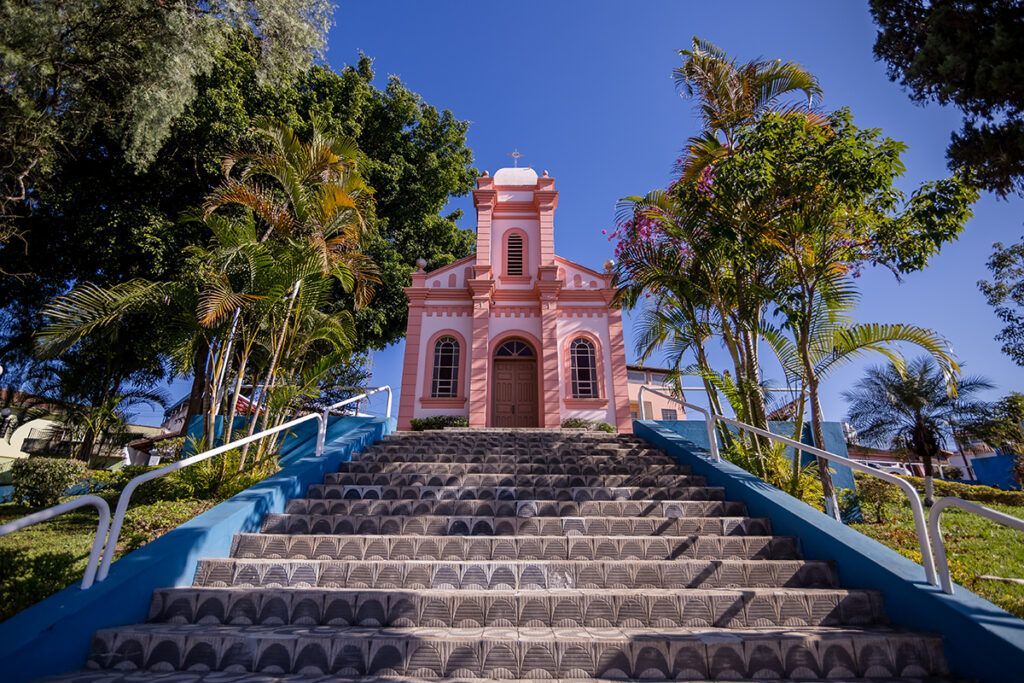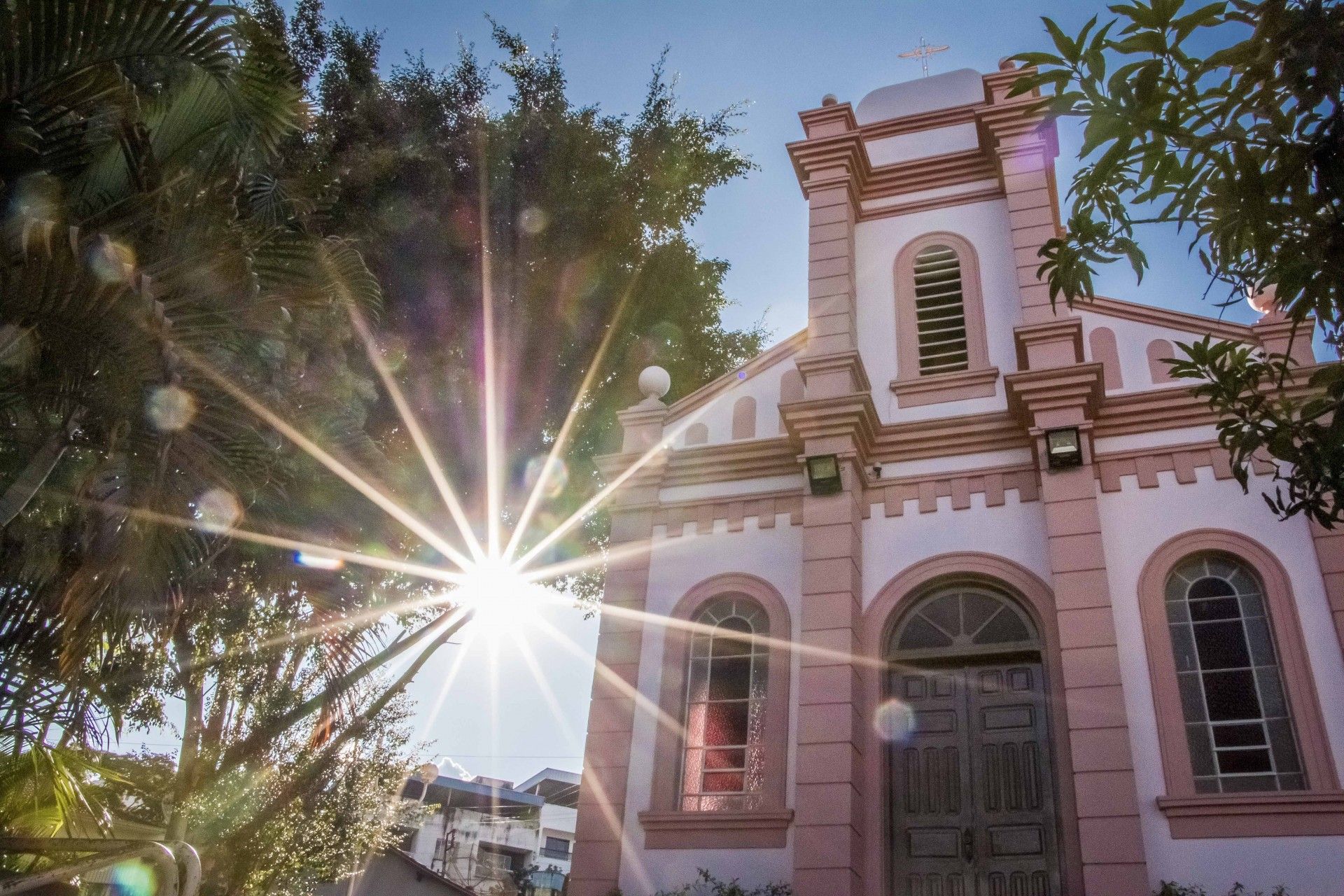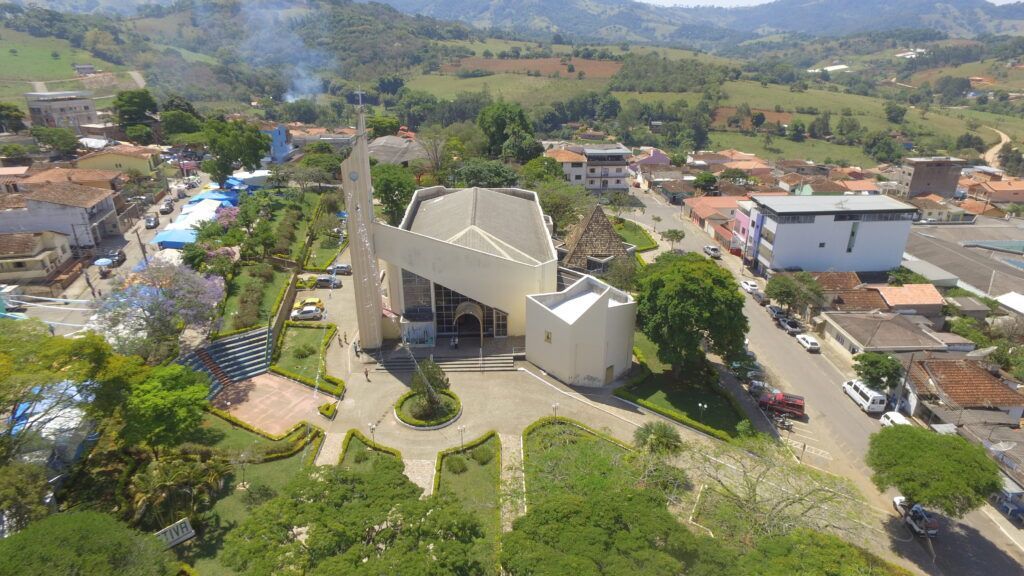Summer - MG
On this page, the Portal Peregrino da Esperança presents the city of Estiva, a small community in Minas Gerais. Estiva is especially known for its strawberry production, which has become a symbol of the city and one of its main economic activities. Our Lady of Aparecida was chosen as the patron saint of the municipality.
🕊️ "Dear Mother, your blessed image and your cloak of hope
brings us comfort and peace."
Features of the City of Estiva - MG
The city of Estiva, located in the interior of the state of Minas Gerais, represents with great authenticity the essence of the small communities of Minas Gerais that, over the years, have managed to preserve their traditions and, at the same time, seek paths to development. Located in the southern region of the state, surrounded by beautiful landscapes formed by hills, valleys and areas of lush vegetation, Estiva charms not only for the simplicity of its urban layout, but also for its cultural richness, the hospitality of its people and the strength of its economy, based mainly on agriculture. The city, whose history is linked to the expansion of the roads in the interior of Minas Gerais during the period when the first towns and villages were formed, received its name due to the improvised passages, known as "estivas", which made it easier to cross marshy lands and streams in the region.
Over the years, Estiva has established itself as an important agricultural hub, and is especially renowned for its strawberry production, which has become a symbol of the city and one of its main economic activities. The quality of the fruits produced in the city is recognized nationwide, which attracts not only merchants but also tourists who visit the city during the festivals and events linked to the harvest. The traditional Strawberry Festival is one of the most important moments in the local calendar, bringing together residents and visitors in a celebration that values the work of rural producers, the culture and the typical cuisine of the region. In addition to strawberries, Estiva's economy also relies on the production of milk, coffee and vegetables, keeping alive the tradition of family farming, which has sustained life in the countryside for generations.
Estiva is not only known for the strength of its rural economy, but also for its welcoming social environment and the strong preservation of the cultural and religious manifestations that are part of the city's daily life. The churches, patron saint festivals, fairs, processions and community gatherings keep alive the identity of a people who are proud of their roots and their faith. Life in the city follows a calm rhythm, where interpersonal relationships are still guided by closeness, solidarity and mutual respect, characteristics that reinforce the residents' sense of belonging and delight those who arrive from outside.
Thus, Estiva stands out as an example of how it is possible to balance economic development, based on the strength of rural labor, with the preservation of a way of life that values simplicity, tradition and community ties. The city continues its path, keeping alive the essence of the interior of Minas Gerais, where the beauty of the landscapes blends with the richness of culture, faith and hospitality, becoming a place where past and present meet harmoniously, building, day after day, a history marked by perseverance, love for the land and pride in being part of this very special part of Minas Gerais.
The presence of Estiva on the Águas da Prata branch of the Caminho da Fé is marked by a unique combination of spirituality, hospitality and natural beauty that transforms the passage through the city into a special moment in the pilgrims' journey. Located amidst the mountains of southern Minas Gerais, Estiva offers hikers not only a support point, but also a pause full of meaning, where contact with nature and the simplicity of rural life combines with the experience of faith that moves each step of the pilgrims towards the National Sanctuary of Our Lady of Aparecida. Upon arriving in the city, the pilgrim is immediately enveloped by an atmosphere of tranquility and hospitality, which reflects the essence of the people of Minas Gerais, always ready to offer shelter, food and, above all, words of encouragement and gestures of solidarity.
The route that takes hikers to Estiva is permeated by stunning scenery, made up of valleys, coffee plantations, strawberry plantations and hills that seem to embrace those who pass by. For many, arriving in the city represents a moment of renewal of physical and spiritual strength, not only through rest, but also through the positive energy that emanates from living with the local community. Churches, squares and small businesses become spaces for exchange, where pilgrims and residents share stories, experiences and reflections on life and the reasons that drive each journey. The city, with its welcoming simplicity, becomes a true refuge on the way, where every detail — from a glass of water offered to a sincere smile — carries immeasurable value for those who follow in search of overcoming, answers and encounter with themselves and God.
For Estiva, being part of the Caminho da Fé is more than just being part of a religious itinerary; it is an opportunity to reaffirm her values of fraternity, strengthen community ties and become part of a network of spirituality that unites different regions, cultures and histories. The constant presence of pilgrims not only boosts the local economy, through inns, bakeries, markets and crafts, but also fosters a human and spiritual exchange that enriches both those who pass through and those who remain. The path leaves its mark on the city, and the city leaves its mark on the hearts of pilgrims, creating a connection that transcends the simple act of walking.
Thus, the passage through Estiva on the Águas da Prata branch of the Caminho da Fé is much more than just a physical stretch of the trail. It is an encounter with the essence of the interior of Minas Gerais, where faith, simplicity, nature and humanity intertwine, offering pilgrims not only a point of support, but an experience that remains alive in the memory and soul of those who pass through there. The city thus becomes an inseparable part of this great path of devotion, hope and transformation, reaffirming that, more than the destination, it is the encounters along the journey that truly nourish faith and give meaning to the journey.
The history of the Igreja Matriz de Estiva, located in the interior of the state of Minas Gerais, is intertwined with the formation and development of the municipality itself, and is one of the most representative symbols of local identity, faith and culture. Since ancient times, when the first residents settled in the region in search of fertile land and a peaceful life in the countryside, the Catholic faith has been an essential element in the social and spiritual organization of the community. It was this devotion that led to the need to build a sacred space where families could gather to celebrate masses, hold baptisms and weddings and strengthen community ties around Christian teachings.
In the early years, religious celebrations took place in a small, modest chapel, built thanks to the joint efforts of the residents, who, with few resources but driven by faith, built the first structures that would become the temple. As the town grew and became a municipality, the need for a larger, more dignified space to house the faithful and consolidate the presence of the Church as a fundamental pillar in the life of the city also increased. It was then that construction began on the current Igreja Matriz de Nossa Senhora Aparecida, chosen as the patron saint of the municipality, reflecting the deep Marian devotion that permeates the religious traditions of Minas Gerais.
The construction of the church was a true landmark in the history of Estiva, not only because of its imposing position in the city center, but also because of the significance it holds for generations of residents. Each stone, each architectural detail and each interior space of the temple preserves the memory of a people who, with faith and unity, built their own history. Over the years, the church has been the stage for the most important moments in the life of the community, being the setting for celebrations that marked the beginning and end of cycles, in addition to the traditional festivities in honor of the patron saint, which mobilize the entire city in processions, festive masses, fairs and gatherings that reinforce the feeling of belonging and solidarity among the inhabitants.
The Estiva Parish Church, with its architecture that combines simplicity and beauty, stands out in the urban landscape as a true point of reference, both geographically and spiritually. Its bells, which echo through the valleys and hills that surround the city, continue to mark the rhythm of daily life, calling the faithful to prayer, celebration and the strengthening of the bonds of faith that sustain the community. More than a physical temple, the church is a space of memory, resistance and hope, which spans generations as a living witness to the strength of faith and the unity of the people of Estiva. Thus, its history remains alive, renewing itself with each celebration, each meeting and each prayer that echoes within its walls, keeping alive the flame of spirituality that has shaped, shapes and will continue to shape the identity of Estiva.
Photographs of the City of Estiva - MG








